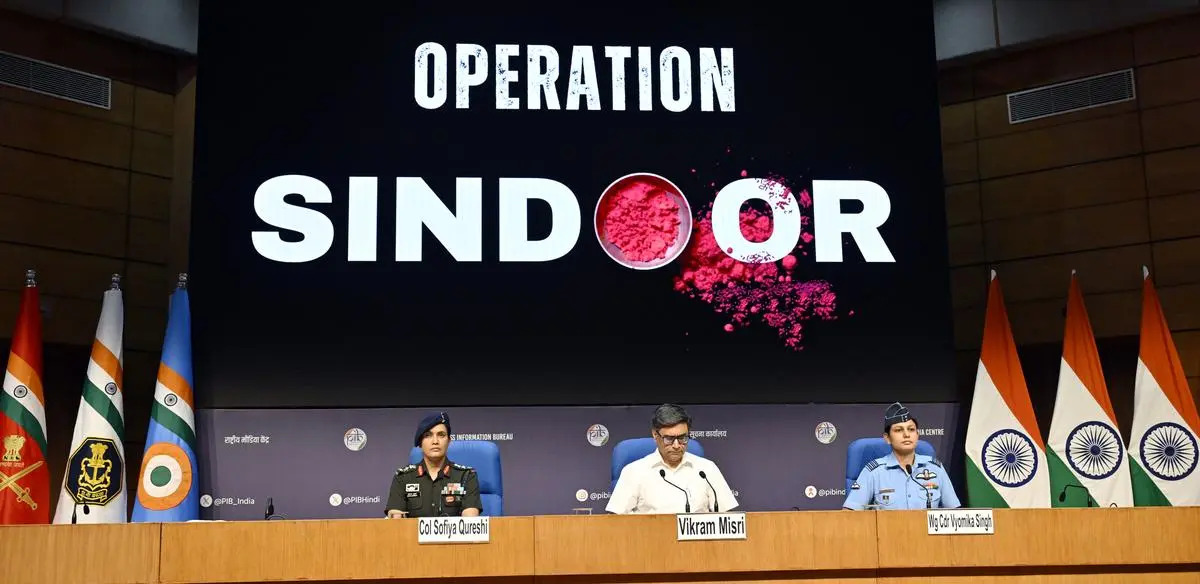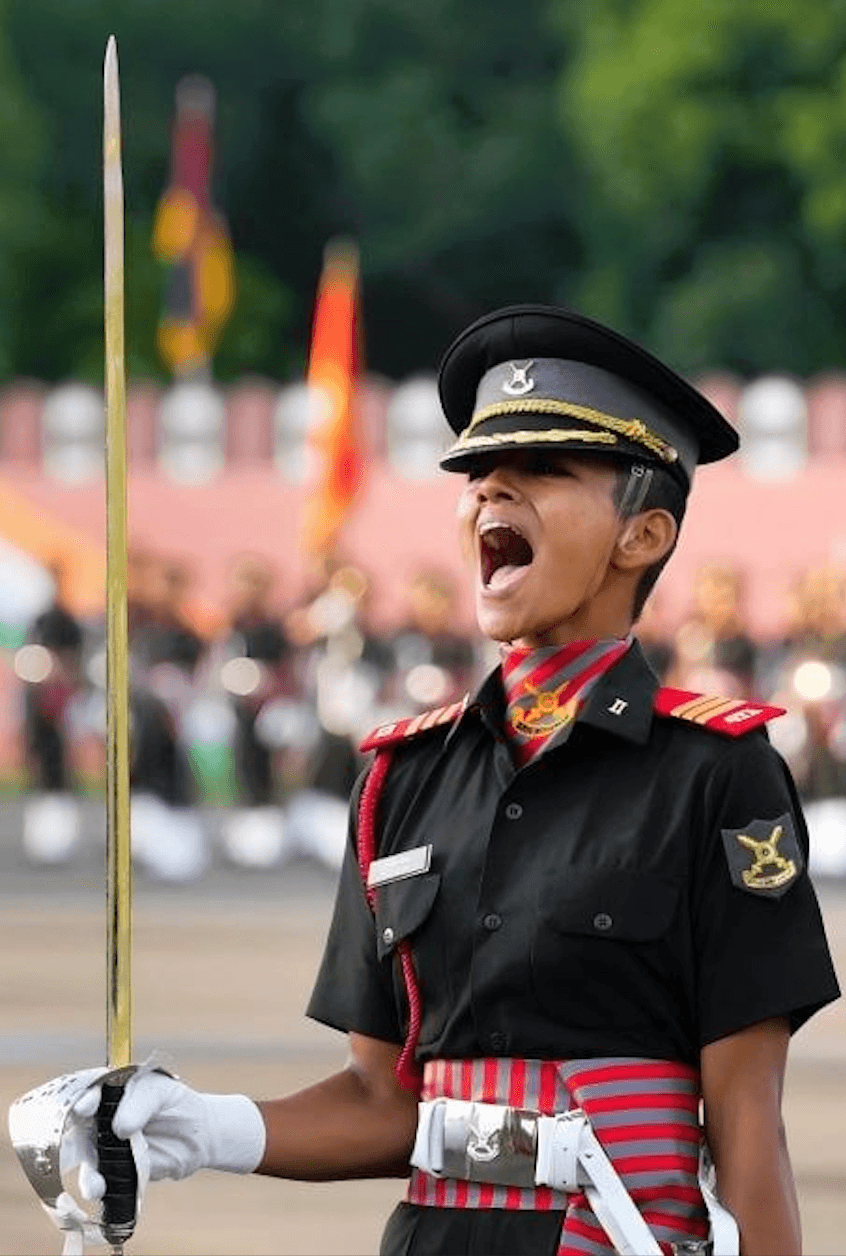Operation Sindoor : The Indian armed forces early Wednesday carried out 24 precision missile strikes on nine terror targets in Pakistan and Pakistan-Occupied Kashmir (POK), including Muridke and Bahawalpur, which are the strong hold soft error groups Lashkar-e-Taiba and Jaish-e-Mohammed, respectively. Over 70 terrorists were killed and more than 60 wounded, significantly degrading the operational capability of these groups.
The attacks, which were carried out in between 1:05 am to 1.30 am, were in response to the terror attack in Pahalgam in Jammu & Kashmir’s Anantnag district that claimed 26 lives –25 Indian sand one Nepali citizen — on April 22.
In an official statement, the Ministry of Defence confirmed hitting terrorist infrastructure in Pakistan and Pakistan-occupied Jammu and Kashmir”from where terrorist attacks against India have been planned and directed.”
India’s actions were focused,measured and non-escalatory in nature. No Pakistani military facilities have been targeted. India has demonstrated considerable restraint in selection of targets and method of execution.
The Defence Ministry said India is living upto the commitment that those responsible for this attack will be held accountable.
India’s strikes come hours before a planned security mock drill across the country for” effective civil defence in the event of a hostile attack”, across 244 districts. Prime Minister Narendra Modi has vowed to pursue the perpetrators of the attack and those who took part in its conspiracy to the “ends of the earth” to inflict punishment on them “beyond their imagination”.
India sent out a”nomore” message against terrorat the government briefing hours after Operation Sindoor, the measured, expansive and swift counter strike against terrorist sites in Pakistan and Pakistan Occupied Kashmir in retaliation for the Pahalgam terror attack.
Before Foreign secretary Vikram Misri, Colonel Sofiya Qureshi and Wing Commander Vyomika Singh took the podium to share details and visuals of India’s unprecedented counter attack against terror, a heart-wrenching video played in the background.
The video showed the heinous terror attacks in India in the past decade. It included the 2001 Parliament attack, the 2002 attack on Gujarat’s Aksharadham Temple, the 2008 Mumbai terror attacks, the attacks in Uriand Pulwama and the Pahalgam tragedy.
“More than 350 Indian civilians have succumbed to cross-border terrorism in the past decade and 800 injured in these dastardly acts of violence. Over 600 Security personnel have laid down their lives and more than 1,400 injured while protecting the Nation from this scourge of cross border terrorism,” a message said. It then added, “…No More”, followed by “Operation Sindoor”.
Sources in the government have said 70 terrorists, including mid-level and senior commanders of terrorist groups Lashkar-e-Taiba and Jaish-e- Mohammed, were killed as India carried out 24 missile strikes across nine locations in Pakistan and Pakistan Occupied Kashmir to avenge the Pahalgam attack. It was a statement of strategic resolve. Through 24 precisely coordinated missile strikes across nine terrorist-linked locations, India demonstrated that it would no longer tolerate cross-border terrorism, nor the complicity of state institutions that enable it.
The way the operation was carried out, the sources said, underscored India’s effort to distinguish between anti-terror operations and full-scale military aggression.The operational timeline was swift. Within less than an hour, all missiles had struck their designated targets. The strikes were synchronised to avoid detection and maximise the element of surprise. Real-time footage from UAVs confirmed the destruction of target facilities. The decision to target deep into Pakistani-administered territory was a departure from prior doctrine and marked a new level of strategic assertiveness.
Twenty-five tourists and a Kashmiri pony ride operator was shot dead in cold blood at Bai saran valley in Jammu and Kashmir’s Pahalgam on April22. Over the past fortnight, Pakistan has only indulged in denials and allegations instead of cracking down on terror groups behind the Pahalgam attack.
Operation Sindoor: How India Destroyed 9 Terror Camps In 25 Minutes
It took just 25 minutes for India to unleash 24 missiles that struck nine terror camps and killed 70 terrorists in Pakistan and Pakistan-occupied Kashmir. The strikes, which lasted from 1:05 AM to 1:30 AM on May 7, were carried out jointly by the Indian Army, Navy, and Air Force under the code name Operation Sindoor.
At a press briefing in New Delhi, Foreign Secretary Vikram Mistri, flanked by Colonel Sophia Qureshi and Wing Commander Vyomika Singh, said the operation was a “measured and proportionate” response to the April 22 terror attack in Pahalgam, Jammu and Kashmir. That assault,attributed to Pakistan-based terror groups,claimed the lives of 26 people, including one Nepali national, and left many others injured.
Unlike the 2016 Uri surgical strikes, 2019 Balakot airstrikes, or other past Indian operations, which were limited in scale and scope, Operation Sindoor was technologically robust, expansive and unlike any mission India has ever carried out. The move to strike deep into Pakistan-occupied territory revealed one thing: a departure from prior doctrine.
Operation Sindoor was not only the most expansive cross-border strike conducted by India since the Balakot operation, butal so represented an evolution in India’s strategic posture.
“The sheer scale of militant loss sent a strong message to terrorist networks and the irhandlers. India now reserves the right to strike preemptively,and no location is beyond reach,” a government source said.
The strikes followed the April 22 terror attack in Jammu and Kashmir’s Pahalgam , where 26 civilians were killed. Intelligence agencies linked the attackers to Lashkar-e-Taiba (LeT), a Pakistan-based terrorist
organisation with a long track record of targeting Indian civilians and security forces. In response, Operation Sindoor was conceived not just as a retaliatory show of force but as an attempt to degrade the logistical and operational foundations of terrorism originating from Pakistani soil.
The Targets
The operation struck nine locations across Pakistan and Pakistan-occupied Kashmir. These included Muzaffarabad, Kotli, Bahawalpur, Rawalakot, Chakswari, Bhimber, Neelum Valley, Jhelum, and Chakwal. The total number of missile strikes stood at 24, making this the most extensive single-day precision operation India has ever executed.
Weapons and Platforms
Operation Sindoor involved a tri-services deployment of air,naval, and land- based assets. The operation utilised air-launched SCALP cruise missiles, HAMMER precision-guided bombs, and loitering munitions. These were fired from Indian Air Force aircraft operating from deep within Indian territory and supported by mid-air refuelling and airborne early-warning systems.
SCALP (Storm Shadow) missiles, with a range of over 250 km, were employed to strike hardened targets, including reinforced bunkers and command posts.
HAMMER(Highly Agile Modular Munition Extended Range) bombs were used against multi-storey buildings believed to house training modules and operational leadership.
Loitering munitions, also known as kamikaze drones, played a dual role: providing real-times urveillance and striking high-value mobile target sas they emerged.
The Full List of Sites Targeted
- Markaz Subhan Allah, Bahawalpur-JeM
- Markaz Taiba, Muridke-LeT
- Sarjal, Tehra Kalan-JeM
- Mehmoona Joya, Sialkot-HM
- Markaz Ahle Hadith, Barnala-LeT
- Markaz Abbas, Kotli-JeM
- Maskar Raheel Shahid, Kotli-HM
- Shawai Nalla Camp, Muzaffarabad- LeT
- Syedna Bilal Camp, Muzaffarabad-JeM
Operation Sindoor: All About 9 Terror Camps
TheIndianarmedforcescarriedout24precisionmissilestrikesonnineterrortargetsin Pakistan and Pakistan-Occupied Kashmir (POK), which are the strongholds of terror groups Lashkar-e-Taiba and Jaish-e-Mohammed.
During a press briefing, the government explained the import an ceofnine terror camps.
- Sawai Nala camp in Muzaffarabad, which is 30 km inside Pakistan, was a key Lashkar-e-Taiba (LeT) training facility. The attack on civilians and Security Forces in Sonmarg on 20 October 24, Gulmarg on 24 October 24 and Pahalgam attack on 22 April 25, were carried out by the terror module which had its germination at Sawai Nala, the Army said.
- Syedna Bilal camp in POK was a staging area of Jaish-e-Mohammed. This camp was used to train terrorists in weapons, explosives & jungle cum survival techniques for carry in gout terrorist activities across Line of Control in Kashmir region.
- Gulpur camp in Kotli, 30 km from the LoC, was a base for LeTterrorist. It was a training centre for terrorists involved in April 20, 2023 attack in Poonch and June 9, 2024 attack on pilgrims.
- Barnala camp It was also the centre for handling arms and ammunition.
- KotliAbbas, 13 km from the LoC, could train 15
- Sarjal camp in Sial kot is just 6 km from the international border. Terrorists involved in the killing of four soldiers in Jammu and Kashmir in March 2025 were trained here.
- Mehmoona Joya camp in Sial kot was a strong hold of Hizbul Mujahideen, a terrorist group. The attack on Pathankot Airbase was planned and directed from here.
- Markaz Taiba in Muridke was a training centre for terrorists involved in the Mumbai 2008 attacks. Markaz Taiba terror base in Muridke, Pakistan, is one of the nine terror bases where India carried out missile attacks. This camp was a training centre for terrorists involved in the Mumbai 2008 attacks, including Ajmal Kasab and David Headley.
- Markaz Subhan Allah, Bahawalpur was the head office of Jaish-e-Mohammed. This was the centre of recruitment, training and indoctrination.
With Operation Sindoor, India exercised its right to respond and prempt, as well as deter more such cross-border attacks, These actions were measured, non-escalatory, proportionate and responsible. They focused on dismantling the terrorist infrastructure and disabling terrorists likely to be sent across to India.
Amid Operation Sindoor, A Look At History Of India- Pakistan Armed Conflict
In response to the Pahalgam terror attack, India launched coordinated missile strikes early on Wednes day on nine terror targets in Pakistan and Pakistan-Occupied Kashmir (POK). The multi-branch military action was carried out under ‘Operation Sindoor’ two weeks after the killing of 26 civilians in Jammu and Kashmir’s Pahalgam. India has blamed Pakistan for the terror attack and accused Islamabad of backing the deadliest terrorist operation in years on civilians in Kashmir on April 22.
India’s latest action adds to alongl is to fmilitary conflicts between the nuclear-armed neighbours. Here is a look at some of the key clashes:
- 1947: First War Over Kashmir Post Partition
- 1965: Second War Over Kashmir
- 1971: War Over Bangladesh
- 1999: Kargil War
- 2016: Uri Attack
- 2019: Pulwama Attack

 Login/Register
Login/Register








